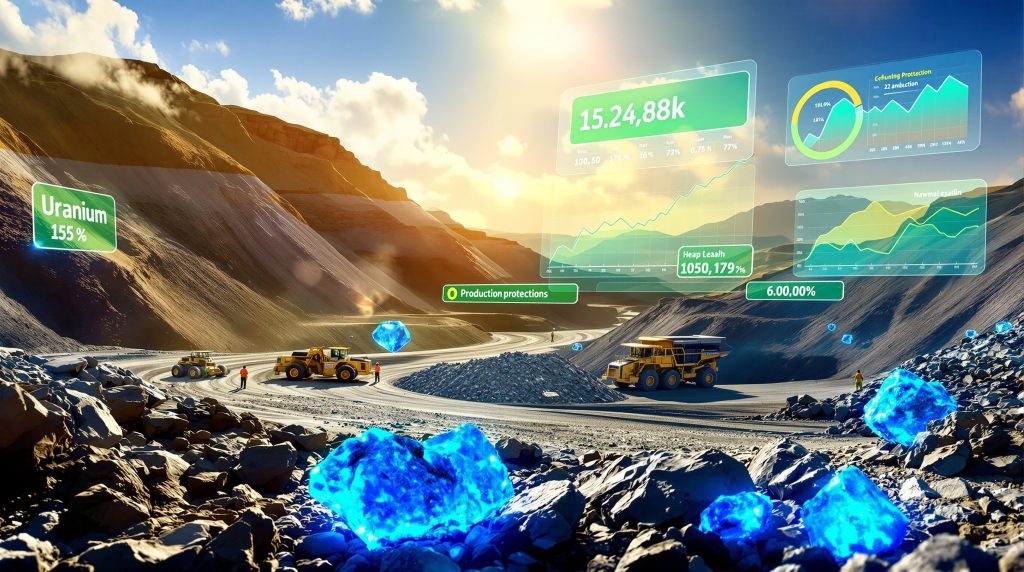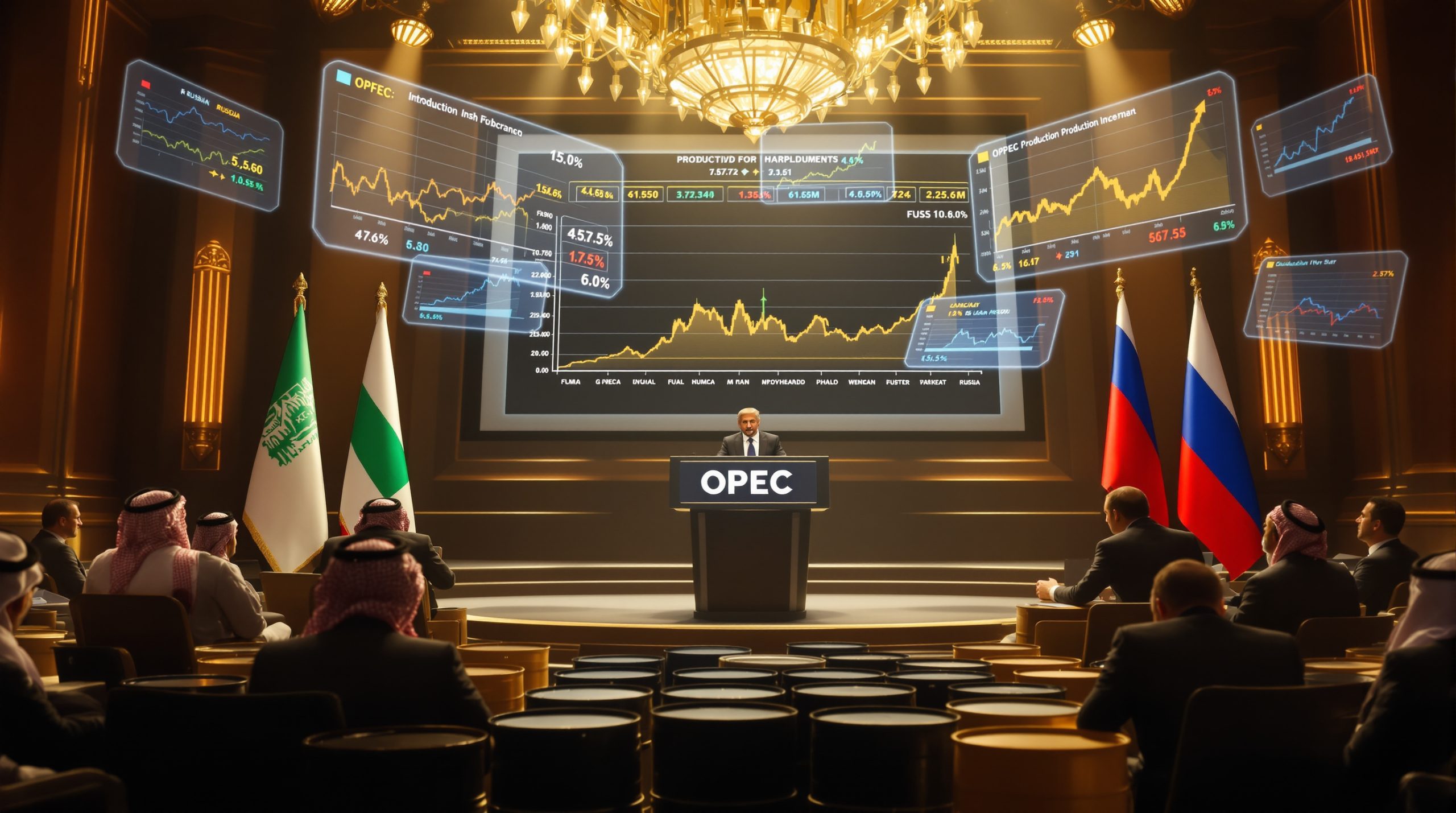What is the Muntanga Uranium Project?
The Muntanga Uranium Project stands as one of Africa's most strategically positioned uranium mining developments, located in Zambia's Southern Province. Currently in the permitting phase with production targeted for 2028, this advanced uranium project is positioned to help address growing global nuclear fuel demand amid worldwide clean energy transitions.
Classified as one of the few near-term uranium developments globally, the project represents a significant opportunity within Africa's uranium landscape. Its combination of favorable geology, established infrastructure, and strategic positioning enables it to potentially serve both Western and non-Western nuclear markets when operational.
GoviEx Uranium Inc. reached a critical milestone in September 2025 with the submission of its comprehensive Environmental and Social Impact Assessment (ESIA) to the Zambia Environmental Management Agency (ZEMA), following a preliminary draft review that received no objections from the agency.
Development Timeline and Strategic Positioning
The Muntanga Project follows a carefully structured development pathway, with environmental permitting currently underway and construction anticipated to begin following permit approvals. The project's advancement comes at a critical time in the global uranium market, with nuclear power increasingly recognized as a key component in the clean energy transition.
As uranium market volatility faces potential supply constraints in coming years, Muntanga's development timeline aligns with projected market strengthening. This positions the project to potentially enter production during a period of favorable pricing dynamics, enhancing its economic viability.
Where is the Muntanga Project Located?
Geographic Setting and Infrastructure Advantages
Situated in Zambia's Southern Province, the Muntanga Project benefits from several strategic location advantages that enhance its operational potential:
- Access to well-maintained road networks connecting to major transportation corridors
- Proximity to reliable power infrastructure from Zambia's national grid
- Position within a politically stable jurisdiction with a pro-mining government
- Established export routes through neighboring countries
- Domestic availability of critical processing inputs, including sulfuric acid
This combination of infrastructure and geopolitical stability provides significant operational efficiencies that enhance the project's economic fundamentals while reducing logistical challenges that often affect mining operations in more remote regions of Africa.
Regional Context and Accessibility
The Southern Province of Zambia offers distinct advantages for mineral resource development, including relatively developed transportation infrastructure. The Muntanga Project's location provides access to established logistics networks that can facilitate both construction activities and eventual uranium product transportation.
Unlike many uranium projects situated in remote or challenging terrain, Muntanga's geographical positioning minimizes infrastructure development costs, potentially allowing for more efficient capital deployment during the construction phase and improved operating margins once production begins.
What Environmental Steps Has GoviEx Completed?
Environmental and Social Impact Assessment Progress
In September 2025, GoviEx submitted its comprehensive Environmental and Social Impact Assessment to ZEMA, a critical milestone in the project's development timeline. This submission followed a preliminary draft review that received no objections from ZEMA, indicating strong initial alignment with regulatory requirements.
The ESIA submission includes several critical components:
- Detailed environmental baseline studies characterizing existing conditions
- Comprehensive social impact evaluations assessing community effects
- Documentation of stakeholder engagement processes
- Environmental management plans for operational phases
- Integrated Resettlement and Compensation Action Plan (RCAP)
The approval process typically extends approximately six months, during which ZEMA conducts a thorough review to ensure compliance with Zambian regulations and international best practices for mining operations. Securing environmental permitting represents a critical path item for advancing the project toward construction.
Regulatory Framework and International Standards
The ESIA has been prepared in accordance with both Zambian regulatory requirements and international best practices for mining development. This dual-standard approach helps ensure the project can meet expectations of potential international financing partners while satisfying national regulatory requirements.
Environmental considerations have been fully integrated with stakeholder engagement and resettlement planning, creating a holistic approach to managing the project's social and environmental aspects. This integration helps minimize implementation challenges and supports community relationships throughout the project lifecycle.
How Will the Muntanga Project Be Developed?
Mining and Processing Methodology
The Muntanga Project is designed as a shallow open-pit mining operation utilizing heap leach processing technology, an approach well-suited to the specific mineralization characteristics of the deposit. Key operational elements include:
| Operational Component | Specifications |
|---|---|
| Mining Method | Shallow open-pit |
| Processing Technology | Heap leaching using weak sulfuric acid and hydrogen peroxide |
| Annual Processing Capacity | 3.5 million tonnes |
| Primary Resource Areas | Muntanga and Dibbwi East deposits |
| Production Ramp-up | Uranium production expected within 4 months of mining commencement |
The processing approach strategically leverages Zambia's domestic sulfuric acid production capacity, reducing reliance on imported chemicals and enhancing the project's cost structure. The heap leach methodology also minimizes water consumption compared to conventional processing, an important consideration for sustainable operations in the region.
Technical Optimization and Process Selection
The selection of heap leach processing for Muntanga follows extensive metallurgical testing and technical evaluation. This approach offers several advantages for this specific deposit:
- Lower capital intensity compared to conventional tank leaching
- Reduced water requirements in a region where water management is important
- Simplified operations with fewer complex mechanical components
- Staged development potential to manage capital deployment
- Well-suited to the specific mineralization characteristics at Muntanga
This technical approach balances economic considerations with environmental factors to create a processing solution optimized for the project's specific conditions and requirements.
What Are the Project's Economic Fundamentals?
Resource Estimates and Financial Projections
According to the January 2024 mineral resource estimate and feasibility study, the Muntanga Project demonstrates robust economic potential across several key parameters:
| Economic Parameter | Value |
|---|---|
| Measured & Indicated Resources | 40 million pounds U₃O₈ |
| Inferred Resources | 7.4 million pounds U₃O₈ |
| Projected Mine Life | 12 years |
| Annual Production (average) | 2.2 million pounds U₃O₈ |
| Operating Costs | USD 32.2 per pound |
| All-in Sustaining Costs | USD 47.3 per pound |
| After-tax NPV (8% discount) | USD 243 million |
| Internal Rate of Return | 20.8% |
| Capital Investment Required | USD 282 million |
These financial projections utilize a uranium price assumption of USD 90 per pound, reflecting market expectations for uranium prices during the project's operational period. The relatively low operating costs position the project competitively within the global uranium production landscape, providing resilience against potential market fluctuations.
Economic Sensitivities and Market Dynamics
The project economics demonstrate particular sensitivity to uranium pricing, with significant upside potential if market prices exceed the base case assumption. At USD 90 per pound, the project's financial returns appear robust, though they would strengthen considerably at higher price points.
With all-in sustaining costs of USD 47.3 per pound, the project maintains a substantial margin against the base case price assumption, providing cushioning against potential operational challenges or temporary market downturns. This cost position places Muntanga in a competitive position among global uranium developments.
What Growth Potential Exists Beyond Current Resources?
Exploration Initiatives and Expansion Opportunities
GoviEx has initiated a comprehensive 2025 exploration campaign focused on expanding the project's resource base and potentially extending its operational lifespan. This exploration program targets several specific opportunities:
- Resource expansion at the existing Muntanga deposit
- Further delineation of the Dibbwi East deposit
- Identification of new uranium mineralization in surrounding license areas
- Exploration of the nearby Kariba Valley region for additional deposits
The exploration strategy employs advanced geophysical techniques, targeted drilling programs, and modern resource modeling to identify extensions to known mineralization and discover new uranium-bearing zones that could enhance project economics.
Potential Economic Impacts of Successful Exploration
Successful exploration outcomes could significantly enhance the project's scale and economics through multiple mechanisms:
- Extending the projected 12-year mine life
- Increasing annual production capacity through resource expansion
- Improving overall project economics through economies of scale
- Establishing Muntanga as a long-term uranium production hub in Africa
- Potentially reducing per-unit operating costs through fixed cost dilution
The combination of known resources and exploration potential creates a two-tiered value proposition: the defined project economics based on current resources, plus additional upside potential from successful exploration activities.
How Does Muntanga Fit Into the Global Uranium Market?
Strategic Positioning and Market Outlook
The GoviEx Muntanga Project is strategically positioned to capitalize on growing global demand for uranium amid the worldwide transition toward clean energy sources. Several market factors create a favorable environment for new uranium projects:
- Nuclear power increasingly recognized as a reliable, low-carbon baseload energy source
- Global uranium supply deficits projected as older mines deplete and demand increases
- Limited new uranium projects in advanced development stages worldwide
- Growing emphasis on supply chain security for critical minerals in Western economies
- Increasing uranium demand from both established and emerging nuclear power markets
Muntanga's development timeline aligns with projected supply shortfalls in the uranium market, potentially allowing it to enter production during a period of strengthening uranium prices. The project's location in Africa also provides geographic diversification for global uranium supply, currently concentrated in a limited number of countries.
Nuclear Renaissance and Supply Constraints
The global nuclear sector is experiencing what many analysts term a "nuclear renaissance," with multiple factors driving renewed interest in nuclear power:
- Growing recognition of nuclear's role in clean energy transitions
- Technological advances in reactor design improving safety profiles
- Energy security concerns following geopolitical disruptions
- Increased policy support for nuclear deployment in key markets
- Rising electricity demand requiring reliable baseload generation
Simultaneously, the uranium production sector faces supply constraints that could create favorable market conditions for new projects:
- Limited new mine development over the past decade
- Production curtailments at existing operations like the Paladin Energy uranium halt
- Reduction in secondary supplies from inventories
- Increasing competition for available uranium supplies
- Growing interest in supply diversification among utilities
This combination of demand growth and supply limitations creates a potentially favorable market environment for Muntanga's development timeline.
What Are the Next Development Milestones?
Path to Production
The Muntanga Project's development roadmap includes several critical milestones that will advance it toward production:
-
Environmental Permitting (2025-2026)
- ESIA approval from ZEMA
- Issuance of Environmental Permit
- Completion of stakeholder consultation processes
-
Financing and Final Investment Decision (2026)
- Securing of project financing package
- Finalization of offtake agreements
- Board approval for construction
-
Construction Phase (2026-2028)
- Site preparation and infrastructure development
- Processing plant construction
- Mining fleet mobilization
- Commissioning and testing
-
Production Commencement (2028)
- Initial mining operations
- Processing plant startup
- First uranium production
- Ramp-up to full capacity
The project team is actively advancing discussions with potential financing partners and evaluating various funding structures to support the approximately USD 282 million capital investment required for construction and commissioning.
Corporate Developments and Restructuring
In parallel with project advancement, GoviEx has announced significant corporate restructuring to strengthen its ability to develop the Muntanga Project. The company recently announced a reverse takeover transaction with Tombador Iron Limited that will see the company rebranded as Atomic Eagle Ltd and listed on the Australian Securities Exchange (ASX).
This transaction is expected to strengthen the company's balance sheet, consolidate its capital structure, and enhance its ability to advance the Muntanga Project. The ASX listing could potentially provide access to additional capital markets and investors with specific interest in uranium investment strategies.
How Does the Project Address Sustainability Concerns?
Environmental and Social Responsibility Approach
The Muntanga Project incorporates comprehensive sustainability measures designed to minimize environmental impacts while maximizing social benefits across several key areas:
- Water Management: Advanced water recycling systems to minimize consumption in a region where water resources are valuable
- Land Rehabilitation: Progressive rehabilitation plans to restore mined areas to productive use
- Energy Efficiency: Design optimizations to reduce energy consumption and associated carbon emissions
- Community Development: Skills training programs and local business development initiatives
- Stakeholder Engagement: Ongoing consultation with local communities and government agencies
These sustainability initiatives are integrated into the project's design and operational plans from the outset, reflecting modern mining industry best practices and alignment with international standards for responsible resource development.
Resettlement and Compensation Planning
A critical component of the project's social responsibility approach is its Resettlement and Compensation Action Plan (RCAP), which has been developed in conjunction with the Environmental and Social Impact Assessment. This integrated approach ensures comprehensive planning for any potential community impacts.
The RCAP follows international best practices for managing resettlement processes, including:
- Detailed household surveys and asset inventories
- Transparent compensation frameworks
- Livelihood restoration programs
- Ongoing monitoring and evaluation
- Grievance resolution mechanisms
This comprehensive approach to resettlement planning helps ensure affected communities maintain or improve their living standards and economic opportunities throughout the project development process.
What Makes Muntanga Competitive in the Uranium Sector?
Comparative Advantages
Several factors contribute to the Muntanga Project's competitive positioning within the global uranium sector:
- Favorable Jurisdiction: Zambia offers political stability and a supportive mining regulatory framework
- Infrastructure Access: Existing roads, power, and support services reduce development costs
- Processing Efficiency: The heap leach method offers lower capital intensity compared to conventional processing
- Market Timing: Development timeline aligns with projected uranium market strengthening
- Experienced Leadership: Project team brings extensive uranium development expertise
- Expansion Potential: Significant exploration upside beyond the current resource base
These advantages collectively position Muntanga as an attractive uranium development opportunity with the potential to deliver value to stakeholders while contributing to global clean energy transitions through nuclear power generation.
Technical Differentiation and Cost Position
Muntanga's competitive profile is further enhanced by its technical approach and cost structure. The project's shallow, open-pit mining method minimizes operational complexity, while the heap leach processing approach reduces both capital and operating costs compared to more complex processing methodologies.
With projected operating costs of USD 32.2 per pound and all-in sustaining costs of USD 47.3 per pound, the project positions favorably on the global uranium cost curve. This competitive cost structure provides resilience against market fluctuations and enhances the project's ability to deliver consistent returns throughout its operational life.
FAQ About the GoviEx Muntanga Project
When is the Muntanga Project expected to begin production?
Based on current development timelines, the Muntanga Project is targeting production commencement in 2028, subject to successful completion of permitting, financing, and construction phases.
What processing method will be used at Muntanga?
The project will utilize heap leach processing with weak sulfuric acid and hydrogen peroxide, a method well-suited to the specific mineralization characteristics of the Muntanga deposits.
How many jobs will the project create?
While exact employment figures have not been finalized, uranium mining operations of similar scale typically create several hundred direct jobs during construction and operations, plus additional indirect employment through local suppliers and services.
What is the expected annual production from the Muntanga Project?
The feasibility study projects average annual production of approximately 2.2 million pounds of uranium oxide (U₃O₈) over the initial 12-year mine life.
How does the project address community relations?
The project includes a comprehensive Resettlement and Compensation Action Plan (RCAP) developed in consultation with affected communities, along with ongoing stakeholder engagement programs and community development initiatives.
Uranium Market Dynamics and Investment Implications
Supply-Demand Fundamentals
The global uranium market is currently experiencing a structural shift that could benefit well-positioned projects like Muntanga. Several factors are influencing this market transformation:
- Global reactor fleet expansion with over 60 reactors under construction globally
- Life extensions for existing nuclear plants increasing long-term fuel requirements
- Production cuts at major operations including Cameco's McArthur River and Kazatomprom facilities
- Depletion of secondary supplies including government inventories and blended-down weapons material
- Limited new mine development over the past decade due to previously depressed prices
These factors collectively suggest a tightening supply-demand balance that could support higher uranium prices during Muntanga's operational timeline, potentially enhancing project economics beyond current projections.
Investment Timing Considerations
For investors considering uranium sector exposure, projects at Muntanga's stage of development offer a unique risk-reward profile. The project has progressed beyond early exploration risk but has not yet required the major capital expenditures of construction. This positioning provides several potential advantages:
- Defined resources and economic parameters through feasibility study completion
- Significant de-risking through environmental permitting progress
- Exposure to potential uranium price appreciation before production begins
- Opportunity to participate in potential resource expansion through exploration
- Relatively short timeline to potential production compared to earlier-stage projects
This combination of advanced development status and near-term production potential positions Muntanga as a differentiated opportunity within the uranium development landscape, particularly given ongoing US uranium disruption and increasing interest in US ISR uranium production.
Future Growth Scenarios
Regional Development Potential
Beyond the current Muntanga Project parameters, the development could potentially serve as a catalyst for regional mineral sector growth. Successful implementation could demonstrate the viability of uranium development in Zambia, potentially attracting additional investment and exploration activity.
The project's infrastructure investments could also benefit other regional development initiatives, creating multiplier effects that extend beyond direct mining operations. These secondary benefits could include improved transportation networks, enhanced power distribution, and skills development among the local workforce.
Potential Expansion Pathways
Looking beyond initial production, several potential expansion pathways could emerge for the Muntanga operation:
- Resource expansion through successful exploration programs
- Processing capacity increases if resource growth justifies additional investment
- Potential satellite deposit development within the project's license areas
- Recovery of secondary products if economically feasible
- Implementation of technological improvements as they become available
These growth opportunities provide optionality beyond the base case 12-year operation, potentially extending the project's economic contributions and stakeholder benefits over a longer timeframe.
Ready to Capitalise on the Next Major Uranium Discovery?
Explore Discovery Alert's proprietary Discovery IQ model that provides real-time alerts on significant ASX mineral discoveries, turning complex data into actionable investment insights for both uranium and diverse commodities. Visit our dedicated discoveries page to understand why historic discoveries can generate substantial returns and begin your 30-day free trial today.




